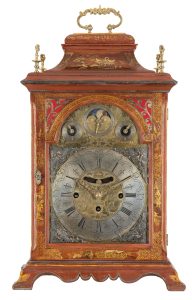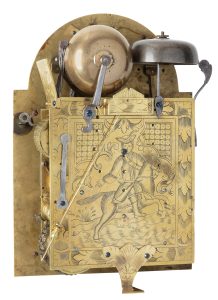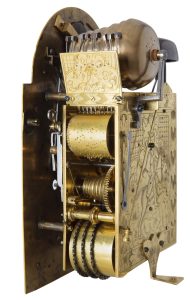Vienna, first half of the 18th century
- signed
- “Mayer in Wienn”
- Clockmaker
- probably Jacob Mayer I,
- Vienna, mentd. 1707, 1709 and 1738
- Case
- fruitwood, chinoiserie painting, partly golden, on red background
- Dial
- engraved ormolu front, silver-plated corner spandrels, silver-plated dial ring and subsidiary dials
- Movement
- verge escapement with fusee, Viennese grande sonnerie with hour strike on bell and quarter strike by carillon with 9 bells, repeater, turn-off for strike and repeater, indication of lunar phase and lunar date
- Height
- 22 in
Chinoiseries are motifs inspired by Chinese, Japanese and Indian art that enjoyed great popularity in the 18th century. The fascination exerted over Europe by exotic and highly developed cultures in South and East Asia was so great that princes and nobility had entire salons set up “au chinois” in their palaces.
Alongside porcelain and silk, lacquer paintings were the most sought-after handcrafted art from the Far East. The exquisite paintings consisting of countless layers of colored lacquer were imported and transformed into European-style furniture or incorporated as panels in wall decorations. But they were also imitated by western artisans using other techniques and domestic materials and given imaginative interpretations.
Viennese Baroque clocks with chinoiserie ornamentation are incredibly rare. Presumably, they were commissioned specifically for interior design “au chinois”. The red fruitwood case of this Baroque clock is embellished with richly detailed paintings featuring figures in Asian clothing, Chinese-inspired architecture, deer, fenghuang birds (mythological Chinese animals) and floral and ornamental elements.
Silver-plated corner spandrels decorate the engraved front. Above the silver-plated chapter ring are subsidiary dials for the turn-off for strike and the turn-off for the repeater. A special refinement is the moon phase at the center of the lunette. The current illumination of the moon is depicted on a rotating engraved and painted disc. A chapter ring encircling this displays the lunar date. This piece, which is identified as having been manufactured by renowned Viennese clockmaker Jacob Mayer I, is also furnished with a carillon – a musical mechanism with a cylinder with raised pins and nine bells – that plays a little melody every quarter of an hour.
A further highlight of this unusual Baroque clock is the engraved back plate. Depicted is a dragoon on horseback in exquisitely detailed uniform. It is possible that this rare representation is a tribute to the most famous dragoon commander in Austrian history – Prince Eugene of Savoy (1663-1736) – who had long been established as a legend by the time this Viennese Baroque clock was created.



